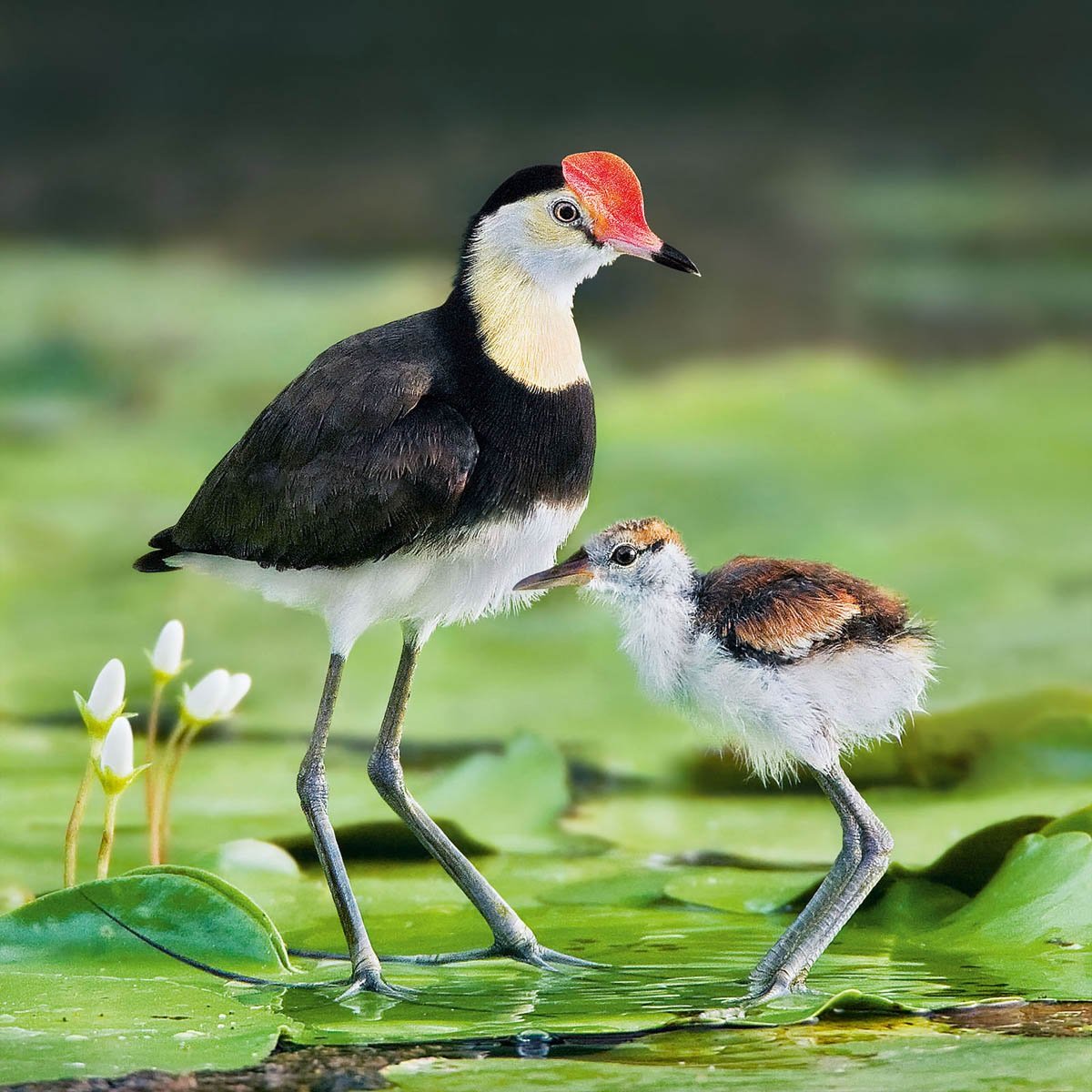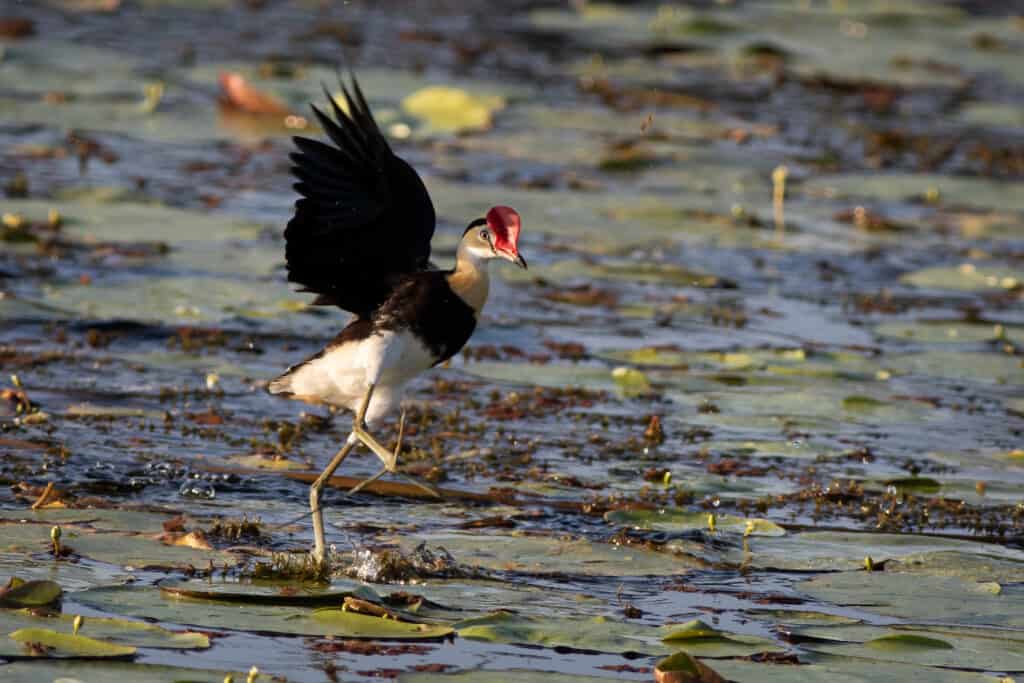Summary
The comb-crested jacana is a sizeable tropical wader from Asia and Australia. It inhabits permanent wetlands year-round with an abundance of aquatic vegetation. You will find it foraging for insects, using its enormous feet to walk across the water. Discover all the interesting facts about this jacana, including where to find it, what it eats, and how it reproduces.

5 Amazing Comb-Crested Jacana Facts
- The comb-crested jacana relies on permanent wetlands with aquatic vegetation for its habitat.
- This species is distinguishable by the fleshy, red wattle on its forehead.
- They have reverse sexual roles, where the females focus on mating, and the males raise the young.
- Fathers pick up their young, carry them under their wings, and bring them to safety.
- These birds are busy foragers, always on the move.
Where to Find the Comb-Crested Jacana
The comb-crested jacana inhabits the northern coastal edge of Australia (Great Sandy Desert, Northern Territory, Queensland, and New South Whales) and lives in five other countries, including Indonesia, Malaysia, Papua New Guinea, Philippines, and Timor-Leste. Its habitat includes freshwater wetlands with an abundance of floating aquatic vegetation. You may find this species in short-grass uplands away from water during the breeding season.
Comb-Crested Jacana Nest
The males alone build a flimsy platform on floating aquatic vegetation. They construct it using stems and plants they find in the water. You will often find it near the water’s edge, partially covered by nearby plants.
Scientific Name
The comb-crested jacana (Irediparra gallinacea) belongs to the Charadriiformes order, a diverse group of birds that eat invertebrates and live near the water. Their Jacanidae family encompasses the jacanas, a group of tropical waders known for their elongated toes. It is the only member in its genus, Irediparra. The comb-crested jacana has three recognized subspecies.
Size, Appearance, & Behavior

The comb-crested jacana is a large bird with unusual and distinguished features. It measures 7.9 to 10.6 inches long, weighs 2.4 to 5.3 ounces, and has a wingspan of 15 to 18 inches. It’s hard to mistake this bird due to its fleshy red, rose petal-like wattle that covers its forehead. It becomes engorged with blood when they are excited. Its body is black to grayish-brown, with a white face and neck and black crown. Like other jacanas, it has incredibly long legs with enormous feet and elongated toes, allowing it to balance and walk across the water. Females have the same plumage, but they are larger and heavier.
This species is relatively social, often seen in pairs, small groups, or large flocks, some living with each other on permanent marshes. Males and females reverse their sexual roles, with females looking for mates and males raising the young. Males can also become aggressive when defending their territory. They are solid and fast fliers, able to fly long distances, but they are just as comfortable in the water as in the air. However, they prefer to stay in the water, and their flying speed is unknown. Their calls are squeaky and high-pitched chitters and trills.
Migration Pattern and Timing
The comb-crested jacana is nonmigratory and lives year-round in its permanent wetland habitat.

Diet
The comb-crested jacana is an omnivore that primarily feeds on insects.
What Does the Comb-Crested Jacana Eat?
This species feeds on insects, mollusks, crustaceans, and various invertebrates. It also supplements its diet with plant material and seeds from water lilies. They forage for food by walking on floating vegetation, using their long legs and large feet to steady themselves on the water. They are busy eaters and always seem to be moving.
Predators, Threats, and Conservation Status
The IUCN lists the comb-crested jacana as LC or “least concern.” Due to its extensive range and stable small to medium population size, this species does not meet the qualifications for “threatened” status. The primary threats to this jacana include wetland habitat loss and invasive species in New Guinea and New South Whales in Australia.
What Eats the Comb-Crested Jacana?
Its wetland habitat can be dangerous, with predators who can attack its nests. The comb-crested jacana’s top predators include birds of prey, water snakes, crocodiles, otters, large fish, and turtles. To protect themselves, they submerge underwater. To protect their young, males carry them under their wings to safety.
Reproduction, Young, and Molting
The comb-crested jacana is polyandrous, meaning it mates with multiple partners. Females will abandon the nest as soon as they lay their eggs, moving on to the next mate. At the same time, males will mate with other females if they lose their egg clutch. This species will breed year-round if they find a suitable habitat with floating vegetation. In Australia, they typically produce during the wet season. Females lay three to four yellowish-brown eggs with black markings, and males incubate for 28 days. Jacanas are born in an advanced state, most able to dive underwater for protection shortly after hatching. They fledge the nest around 50 to 60 days old. They molt for the first time around one year and live an average of 4.8 years.
Population
The global population for the comb-crested jacana is unknown, but there is no evidence of extreme fluctuations or fragmentations in their numbers. Researchers are unsure of the impact of habitat modification on their population size, so their exact numbers are difficult to determine. However, this species appears to be stable.





